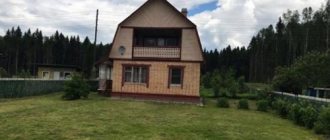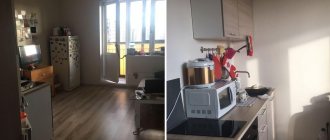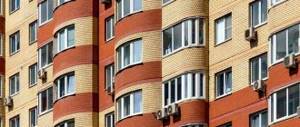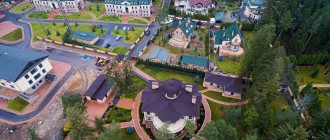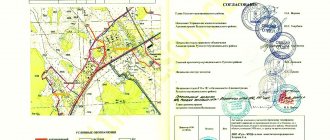Good afternoon friends! Continuing the series of articles by a professional private realtor on the purchase and sale of secondary real estate, today I invite all applicants on the market to literally lift their heads to the sky and turn their gaze towards apartments on the very top floors.
In the prepared material, I tried to discuss this topic with you in detail and objectively, from all angles and in all planes. As part of the subject of discussion, all the advantages and disadvantages were analyzed, as they say, all the pros and cons of this type of housing. In addition to answering the main question: “Is it worth buying an apartment on the top floor,” the article touches on several important related aspects - I’m sure that everyone will notice something useful for themselves. After reading, you will learn:
- To what extent are similar objects of interest to professional participants in their investment plans?
- Why the higher the floor, the more expensive the apartment
- Is it worth taking an apartment on the last level in a panel house without a technical floor?
- This is why some clients do not want to buy an apartment on the highest echelons and tiers
- What exactly are the risks of purchasing square meters in the sky?
So, get ready - it will be interesting; go…
Advantages (pros) of an apartment on the top floor:
View and overview
Gorgeous views and all-round visibility are the parameters, first of all, for which potential buyers consider purchasing housing on the upper and, in particular, on the top floors. The picture in many cases is truly stunning - the urban area and all the details of the area are in full view - it is a captivating and breathtaking beauty!
Psychology of Excellence
The last floor certainly affects a person’s fate, and the practical benefits are obvious - if you are not lazy or a complete cretin, then soon the positive consequences will make themselves felt and not only visually the whole world will lie at your feet. The awareness that you live above everyone, above everyone, not only balances the individual and has a beneficial effect on the general psychological state of the individual, but incredibly greatly raises a person’s self-esteem, strengthens and stabilizes mental immunity, and sets him on the right path. Living at a bird's eye view inspires the owner and provides all the prerequisites for personal development and career growth, and as a systemic result, people become successful in life and achieve a lot.
No neighbors above
Those living on the top floor forget how to knock on the radiators in order to calm down their angry and unruly neighbors. No one is walking on their heads, no one is running on the ceiling, the chandeliers are not swaying from side to side, no one is bothering you. This is a clear advantage - worth thinking about!
Transit has no place here
“The train is not going any further, please vacate the carriages” - something like this can be said with humor about those living on the highest floors. There are no strangers here, and from the point of view of personal comfort and safety, this is perhaps the best level in the house. The floor is a dead end, not accessible. Excuses and excuses such as “I had the wrong door”, “I was walking or passing by” - will not work here. The absence of transit pedestrian traffic is another clear plus in the treasury of the subject of discussion
No threat of flooding
What the owners of residential premises on the highest floors can be sure of is that none of their neighbors will ever be able to flood them, even with their best wishes. This circumstance is a clear advantage of apartments on the top floors.
Good for your health
When I bought myself an apartment on the top floor in a brick building without an elevator, a friend congratulated me on joining the pacemaker club. And indeed, walking several times a day from first to fifth and back can be regarded as nothing other than free fitness. Healthy legs and a strong body are all advantages!
More light and happiness
As the sun sets, the shadow slowly creeps along the facade of the building from bottom to top - the heavenly body caresses with warmth until the last and illuminates the upper floors. In addition, there is a scientifically proven fact that rays promote the production of serotonin (the hormone of happiness). Perhaps it is for this reason that the residents on the top floors are always positive and it is not for nothing that people from the outside seem a little happier.
A little warmer
And now I propose to delve into the palaces of the mind and remember the lessons and elementary laws of physics - heat invariably rises upward, that’s exactly what natural science says! For people who are freezing, always and everywhere, under any temperature conditions, experiencing pathological cold, I am sure that the top floor is the best choice for personal living.
Significantly quieter
Extraneous sounds from the street reach the upper floors noticeably weakened. I know firsthand that background noise from passing vehicles or a nearby construction site on the last level of a building is much easier to bear.
The air is cleaner
At an altitude of 17 or 25 floors, the air is, of course, more rarefied, but it is still much cleaner. Heavy particles, which cause immediate irreparable harm to health, do not fly so high, but settle below and immediately. Clouds of gas formations reach the upper echelons, but are already greatly diluted with the freshness of purity.
Upper apartments in new buildings
Apartments on the top floor - resale and new buildings
As has been said many times, modern high-rise buildings have a lot of advantages, including the upper floors.
However, you should not count on a discount for the last floor. So, apartments on new floors have a lot of advantages:
- No upstairs neighbors. In new houses, as a rule, audibility is very good, but soundproofing the floor is much cheaper.
- Roof leakage is excluded. Modern buildings include one more floor, and a new roof will help you avoid leakage problems in the future.
- In modern high-rise buildings, all communications are located on the technical floor. This means that water flows from top to bottom, and not vice versa. This will ensure a good supply of water and heat.
- An order of magnitude less dust, exhaust gases and noise from the street. You will not hear alarms or horns ringing.
- Wonderful view from the window.
- Throwing cigarette butts onto your balcony or washed clothes is excluded.
- Modern elevators rarely break down, and you won't have to squeeze into a crowded elevator. In addition, the presence of 2 elevators (freight and passenger) will eliminate the situation when new neighbors move, and you need to go down or up to your floor.
- The premises are brighter.
- There will be no instructions from the fire department that it is necessary to open the passage for neighbors through your loggia.
- No one will be flooded with sewage.
All positive factors apply only to new houses of modern construction. In addition, when purchasing an apartment on the top floor, you need to clarify the location of the elevator in order to avoid unpleasant sounds and annoying noise.
The negative aspects in new houses include constant heat regardless of the time of year and complete dependence on the elevator, and you won’t be able to keep an eye on your car, which is parked in the yard.
In conclusion, I would like to note that when choosing an apartment on the top floor, it is necessary not only to carefully examine all the premises, but also, if possible, to communicate with neighbors who can tell you about the advantages and disadvantages of such living space.
Practice suggests that unpleasant situations and problems associated with the upper floor arise much more often in old houses than in new modern buildings.
The apartment is on the top floor. Cons and pros:
See also Phone numbers for consultation March 14, 2021 kasjanenko 1514
Share this post
Discussion: 4 comments
- Alexander says:
08/23/2019 at 07:00On the top floor the air is fresher and there is more sunlight. And there will be fewer problems with neighbors, in any case they won’t flood you. But roofs can still leak; this happens all the time.
Answer
Peter says:
04/03/2020 at 14:29
But if you cause a flood, then all the lower eight floors will suffer. And everyone will come with claims. In this regard, an apartment on the first floor is more practical. But seriously, it seems to me that the top floor is not a bad option at all.
Answer
06/10/2020 at 01:59
I have absolutely nothing against an apartment on the top floor. My mother lives in a Khrushchev-era building without an elevator on the top floor of a three-story building and feels great, and we live in an improved-plan house with an elevator on the fifth floor of a nine-story building, and either the neighbors from above will flood us, or they will stomp over our heads until the morning. In general, we dry our laundry only inside, and if you just stick your head out of the balcony, a cigarette butt can fly from above or something worse. So living on the top floor is even better.
Answer
08/14/2020 at 20:43
I would not buy an apartment on the top floor if the cost is not much different from the cost of an apartment on the middle floors. There are no neighbors upstairs, but the roof heats up in summer and vice versa in winter. It makes it cold and it may also leak, and then this will be a very big problem.
Answer
Disadvantages (cons) of apartments on the top floor:
Leaks
As sociological research and personal practice show, what potential buyers of secondary real estate on the top floors fear most is leaks due to leaky roofs. Ceilings, or rather thin roofs, are the Achilles heel of almost all apartments on the highest floors. Traces of rainwater stains on walls and in corners are a fairly common attribute. Many sellers in similar situations try to hastily disguise the problem or completely hide this unpleasant fact from bona fide purchasers, and therefore hidden defects are one of the most common causes of conflicts of interest in the market. “Doesn’t the roof of your house leak?” - this is the first question that clients ask over the phone or when viewing premises live. “No, we’re fine with that!” And in my lifetime, none of the owners have immediately admitted to the existing problem on their own!
Elevator noise
Elevator facilities and the shaft are sources of increased noise inside the building. The metallic grinding and clanging noise from the operation of the lifting mechanism, which is located in the technical room above the shaft, is an integral part of life on the top floor. In some cases, even additional soundproofing of the apartment does not help to correct the situation. Existing side by side with an intractable problem circumstance sometimes becomes simply impossible - and how could it be otherwise when one of the residents and neighbors constantly calls the elevator to the floor every minute!
Atmosphere pressure
As you know, as you gain altitude, atmospheric pressure decreases. People (mostly elderly) who are sensitive to jumps and changes in the barometer needle will not feel comfortable and confident on the upper floors. This may result in symptoms such as nausea, weakness and dizziness.
Water pressure
The classic version of water supply circulation for most residential premises on the secondary level provides for the supply of energy resources from the bottom up. It is for this reason that in apartments on the last levels of panel high-rise buildings from the times of the Soviet Union, the 90s and early 2000s, insufficient or very weak H2O pressure may be felt. In many modern new buildings, the problem with pressure in the system was solved in a radical way - they changed the circuit in the diametrically opposite direction - where water and heat are supplied to the houses with the help of recirculation pumps from top to bottom.
Fire risk
The height of the building, 17-25 floors, sometimes becomes an insurmountable obstacle for residents. The likelihood that in an emergency the length of the fire escape is not enough for rescue is quite high. The threat of losing one’s life, for example, as a result of just a short circuit of faulty household electrical equipment (kettle, toaster or microwave) is one of the key risk factors for apartment owners on the upper, and, of course, on the top floors. In this regard, living closer to the ground is much safer, because jumping from a first or second level window during a fire is certainly more convenient.
Foreign odors
Aromas, as well as warmth in principle, most often rush upward. And if a person lives in an apartment on the top floor, then with an open window an explosive mixture of stench or luxurious bouquets of a wide variety of odors are guaranteed with 100% probability.
Very windy
Those who have been living in their apartments on the high top floors for a long time will not let you lie that in a strong wind you can literally feel the house swaying from side to side. The rolling amplitude may not be large at all, but it really exists - the designed vibrations in many cases occur within the limits of permissible urban planning standards. Residents with regular manifestations of the power of the elements may experience rare discomfort - this is clearly not the place for comrades with a weak vestibular apparatus.
It's not life without an elevator
During the period when I lived in a new high-rise building near Moscow, something was constantly breaking down in our house and the energy supply was very often turned off: both water and electricity. Returning from work, I often managed to see a long-suffering picture: on the doors there is a sign “the elevator is not working,” and residents from the 15th or 17th floor are sitting with bags from the store on a bench in front of the entrance and waiting for the poor fellow until the repairman comes or turns on the light. Carrying heavy trunks on your back into your home is a task that not many people can do. Many times I caught myself thinking that in the case of a new building I did the right thing when I settled on an easily accessible second floor. I know firsthand that in high-rise buildings there is an acute dependence on the elevator; in many cases, in apartments on the top floors it is absolutely impossible to do without a lifting mechanism.
More expensive delivery and lifting to the floor
The price lists of many transport and logistics companies are formed in such a way that the goods are delivered to the customer free of charge, but only to the entrance. To deliver a parcel to the door of an apartment, the buyer will have to pay extra to the courier for each floor he passes, and in cases of large-sized items, special tariffs and increasing coefficients are applied - the services of professional movers for careful and careful transportation will cost the client a pretty penny. An apartment on the top floor obliges the owners to live up to a respectable status - be prepared to incur large financial expenses and expenses and, on occasion, to fork out significantly.
Modern advantages of the top floors
Modern houses, for the most part, have gotten rid of the shortcomings that existed in apartments on the top floors of houses built in Soviet times. Roofs do not leak so often anymore, and good results have been achieved by the presence of a technical floor and the separation of the elevator shaft from the apartments by a hall.
Houses with new layouts are being built higher and higher. The last floor is less and less perceived as a disadvantage. The low cost of an apartment located on the top floor most often concerns old houses and economy-class buildings.
In high-class buildings, apartments located on the top floors are priced equal to the cost of housing on the middle floors, and sometimes even an order of magnitude more expensive.
Bonuses of an apartment on the top floor:
- the possibility of installing a fireplace, not only as a decorative element, but also quite functional;
- the opportunity to have a romantic dinner on the roof;
- Possibility to organize a storage room on the technical floor.
Technical floor is a separate sore subject
The largest number of complaints from those living at the very top are connected precisely with the technical floor - curses, prayers and spells are poured into its address in the hundreds, if not thousands, every day. Indeed, the condition of the attic often leaves much to be desired - utility workers, as a rule, first of all clean up the mess below, and they rarely get around to leaks on the roof. Much in this matter depends on the type of roof of an apartment building (flat, gable), air circulation and the height of the technical room. Before purchasing, I recommend that you conduct a visual inspection of the rafter system and make sure that the roofing material is tight, and if it is impossible to independently examine it, contact the management company or the office of the government agency operating the civil building for appropriate clarification. And in the case when the apartment is on the very last level and without a technical floor, that is, the outer reverse side of the slab (ceiling) is also the roof of a residential building, then before purchasing such a specific object, the client really needs to think seriously - maybe the game isn’t worth the candle? ! The risk of peeling of plastered mineral surfaces as a result of leaks and the formation of fungus and mold on the walls is indeed quite high.
Which floor to choose when buying an apartment
Which floor is better to live on? This is a question that many people have faced. In new buildings, similar apartments on different levels usually cost almost the same. But when buying housing on the secondary market, prices depending on the floor can vary by 10–15%.
Let's consider the main factors affecting the quality of life in connection with the height above the surface. They can be grouped into the following main categories:
• safety;
• comfort;
• ecology
Safety
A characteristic feature of the first floor apartments is bars on the windows. The lower levels are the most dangerous from the point of view of possible penetration into housing. It is much easier for a thief to get into an apartment on the 1st floor than on the 6th. Previously, there was even such a thieves’ specialization - “window makers.” Criminals of small stature and puny build managed to enter the apartment right through the window!
Even if all the windows are tightly closed, it will not be difficult for a professional swindler to open the frame with a screwdriver or chisel. Therefore, residents of all first floors, and often the second and even third floors, have to install bars. After all, very much of the building’s design allows easy access to these levels through canopies, balconies and other architectural elements.
There is a certain danger of penetration into the apartment on the highest floors. Thieves can get into the home here through the roof, technical floor, balconies, etc. However, the degree of risk here is less than on the lower floors. And the safest ones are apartments on the middle levels.
Fire safety
Subconsciously, any person understands that the lower he lives, the greater the chance of surviving a fire. In reality, the danger on the first floor may be slightly higher than on the second or third - due to the already mentioned bars on the windows. Although usually residents of the lower floors manage to leave burning buildings in time. It's worse for those who live high. The fire can cut off their escape route up the stairs. And you won’t jump down from a great height either.
The only hope for many residents of the upper floors in the event of a fire is the arrival of rescuers. The fire-fighting crews of the Ministry of Emergency Situations have special equipment with retractable ladders. However, the height of such stairs is extremely limited. In most cities, their maximum dimensions are 30 meters. This is approximately the 9th–10th floor. In some cities, stairs extend 50 meters, up to the 17th floor.
In Moscow there are several telescopic lifts with a height of 90–100 m. They are able to reach the 27th and 33rd floors. Considering the capital's distances, you shouldn't hope for their quick arrival in the event of a fire. In addition, their work at high altitudes is very limited by weather conditions.
From a fire safety point of view, all floors above the 9th are most dangerous. Your city may simply not have stairs of the required length. And if it is available, the crew needs time to get there.
Comfort
Here we can highlight several main criteria related to the floor of residence.
Noises and extraneous sounds
The worst sound environment is on the lower floors. Here you can better hear traffic and conversations on the street. If there are benches under the windows, then noisy companies can disturb sleep even at night.
The door may slam at the entrance, and the neighbors are constantly walking up and down the stairs, leaving and arriving in the elevator. Mothers rattle their strollers, cyclists rattle their vehicles.
On the highest floors there is less sound from the street or courtyard. But the walls here are thinner than below. Therefore, it is much better to hear what is happening with your neighbors. Plus, on the top floor you can clearly hear the operation of elevators and pumps.
In general, in terms of acoustic characteristics, apartments in the middle of the building, approximately 4–7 floors, are preferable.
Illumination and sun rays
Natural light is better on the upper floors, approximately from the 5th and above. On the lower levels, the light may be blocked by neighboring buildings and tall trees.
On the other hand, if the apartment is not very well located, direct sunlight can cause inconvenience (this is more typical for the southern regions). On the top floor, the roof can become very hot in summer. The presence of shade from tall trees will be a preferable factor in this case.
Insects and dust
The amount of dust decreases with height. Most of it is on the first floor. The situation with insects is similar, although there is no big difference between the 1st and 4th or 5th floors. But as the altitude increases, the wind becomes stronger and simply carries all the midges to the side. Therefore, there will be fewer insects on the upper floors. Although the same mosquito can fly to the 12th floor.
Climbing to the top
Today there are elevators almost everywhere. However, in old houses they often break down. The lower, the less stress on the body in extreme situations. This is especially important for older people. Therefore, many retirees prefer apartments below.
If you need to deliver furniture, heavy household appliances, building materials to your apartment, or take out the trash after renovations, in all such situations the lower floor will be an advantage. Such items may simply not fit into a freight elevator, and the services of loaders will be expensive.
Ecology and health
From a health and environmental point of view, the quality of life is influenced by several multidirectional factors.
Air purity
The dirtiest air is below. The exhaust gases are quite heavy and do not rise high. The lightest factions are maximum up to the 4th–5th floor level. Therefore, gasoline and diesel exhaust are concentrated in the area of the three lower floors.
If there are industrial enterprises nearby (especially thermal power plants, metallurgy or chemical production), then the smoke from them will rise higher. The most dangerous zone for such combustion products is between 8–16 floors.
If you live in a relatively environmentally clean area, then apartments above the 5th floor are preferable. If there is industrial production nearby, then from 5th to 7th and then above 16th.
Geomagnetic conditions
Historically, man is a terrestrial creature. Our ancestors lived in caves, huts, huts. Therefore, constant exposure to high altitude often has a bad effect on well-being and psyche. With each floor, the level of the earth's magnetic field decreases. This leads to decreased immunity and can cause cardiovascular problems.
Building materials such as concrete and brick further weaken the level of the geomagnetic field. Our body feels this as an even greater distance from the surface of the earth.
Of course, these factors do not apply to everyone. There are people who, on the contrary, are “pressured” by the mass of floors above their heads. And the higher the building, the stronger it is. It is not surprising that in the West more and more citizens prefer to live in low-rise suburbs.
Electromagnetic vibrations
In a modern apartment building, hundreds or even thousands of different electrical devices are constantly functioning - from a refrigerator to a cell phone. The radiation from all these devices creates a vast field enclosed inside a reinforced concrete house, like in a cage.
The greatest intensity of this field is concentrated on the upper floors. Various television, radio receiving and transmitting antennas (for example, cellular base stations) can also be located there.
Strong radiation can also be present on the lower floors - if electrical equipment is located in the basement.
Comparison of different floors
Having studied individual factors, let's move on to considering specific floors. Let's start from the bottom.
First floor - pros and cons
The first floor has few advantages. There is no need to wait for the elevator or walk upstairs if it is not working. Convenient delivery of goods and purchases. In case of fire, the path to salvation is the shortest.
There are many more disadvantages. You have to have bars on the windows. There is a lot of noise coming from the street or yard. The level of air pollution from exhaust gases is high. Neighbors are constantly walking up the stairs, bicycles and baby strollers are rattling on the landing, the elevator is noisy, and the front door slams.
Dampness, fungi, and harmful radiation can spread from the basement; unpleasant odors and unsanitary conditions can spread from the garbage chute. This is fraught with the appearance of rodents, mass reproduction of mosquitoes, flies and midges.
For these reasons, apartments on the ground floor are usually 10–15% cheaper than comparable housing on the middle levels. However, this can be an additional advantage when older people buy an apartment.
Top floor
If we exclude modern expensive penthouses from consideration, then we can also count many disadvantages for the upper floors. Proximity to the roof is associated with the risk of exposure to precipitation. If there is no technical floor, then the roof is actually the ceiling of the apartment. It might just leak. Even the presence of a technical floor does not guarantee one hundred percent protection from rain and melting snow.
In summer, the roof can become very hot, creating an “oven” mode inside the apartment. You will have to install an air conditioner, which will consume a lot of electricity. On the top floor there is often an increased level of electromagnetic radiation. If there are industrial enterprises nearby, then from the 8th to the 16th floor the most dangerous concentration of emissions is recorded.
The walls at the top of the building are the thinnest. Because of this, sounds from neighbors' premises penetrate into the apartment. Vibrations that are harmful to health may occur in the walls. Another disadvantage is the weakened geomagnetic field.
If the elevator fails, getting to the top is extremely inconvenient. And in the event of a fire, this area becomes especially dangerous.
The top floor also has its advantages. It's a good vantage point with panoramic views from the balcony. Low noise level from the street. Clean air without dust and exhaust gases (if there are no factories or heating plants nearby).
In general, apartments on the top floor are cheaper than those on the middle levels. Therefore, it makes sense to invest in housing on lower floors. In case of resale, you will lose significantly less on the price difference.
Which floors are optimal for buying a home?
It is best to buy apartments in the middle part of the building. If this is a 5-story building, then the 3rd floor looks optimal. There is already less noise and smells from the street, but it is still not too high to climb the stairs. It’s also a long way from a hot roof with possible leaks.
In nine-story buildings, the 4th–6th floors look best. In modern high-rise buildings there are apartments on 4–8 floors. Experienced investors first of all buy housing on the 5th–7th floors, then on the 4th and 8th.
Much depends on the area, the location of a particular residential building, and even the orientation of the apartment itself to the cardinal points. It is not advisable to buy housing higher than 7-8 floors near industrial zones. And in an ecologically clean area, an apartment on the 9th-10th floor of a high-rise building can look quite attractive.
Don't offer the last one?!
Everything flows, everything changes, and the real estate market does not stand still. It is constantly evolving - new patterns and trends appear. What was obvious and categorical 10-15 years ago has now become less clear-cut. The issue of illiquidity of the last floors, in turn, has also undergone significant changes. The stereotypical phrase that has been developed over the years is “Do not offer the first and last!” — has noticeably decreased recently, because it lost its relevance in its last part. Apartments and apartments on the upper floors are held in high regard and in price - and with this stubborn circumstance, in fact, one can argue for a very long time, but in the end, one cannot but agree!
Features of the apartment on the top floor
The peculiarity of the apartment on the top floor is that it is located under the roof. Apartments on the top floor have both their pros and cons. If we take old buildings, then these apartments will always be 10-20% lower on the market.
Why are apartments on the top floor cheaper? First of all, with the fact that dampness, leaking roofs, and problems with communications are often found on the upper floors. Owners of apartments on the upper floors say that the apartments are cooler, and if the building does not have an elevator, it is quite difficult to climb.
However, these problems are typical of old houses; modern technologies and developers, on the contrary, have made the upper floors elite. Now the top floor, that is, the penthouse, is considered the most expensive living area of the entire house. But is it worth taking an apartment on the top floor?
Should I buy apartments on the lower floors?
We studied the first residential floors in this article. Let's discuss the second and third levels of the secondary building, which are considered the lower floors. First let's name the cons.
Street noises
. With the windows closed, there is practically no street noise, but in the summer the window sashes are open. Passing cars are noisy, and the conversations of passers-by and neighbors talking on benches can be clearly heard.
Dusty air
. A consequence of the proximity of the roadway and frequent windy weather is the stable penetration of dust into the “lower” apartments.
Insects and rodents
. Invasion of foreign living creatures is a common problem in the lower levels of high-rise buildings. However, with sufficient professionalism of management companies, the problem of rodents and insects is completely solvable.
Risk of entry
. Most often, attackers are interested in the windows of the three lower floors, as they are the most accessible from the street. Note that the window grilles of the apartments on the first level of an apartment building can become a “staircase” for entering the windows of the second floor.
Street cold
. The air in the entrance at the level of the first and third floors cools more in winter than on the staircase tiers above. Accordingly, every time the front door is opened, cold air enters the apartment. Most of the cold comes in if the front door does not close in winter.
The last “minus” of the lower floors applies to high-rise buildings of the old housing stock, since new buildings have an entrance vestibule separating the street and the staircase with two door blocks with tightly closing door closers.
When analyzing which floor to buy an apartment on, a potential buyer will pay attention to the advantages of the lower level floors. Let us remind you that we are talking about the second and third floors, since the first floor is considered in a separate article.
Proximity of exit
. It is much easier to evacuate from the second or even third floor during an earthquake or fire than from apartments on higher levels.
Elevator independence
. It is easier for residents of the lower living quarters to get into an apartment with a faulty elevator (any equipment breaks down periodically). And going down the street is even easier.
summer shade
. Trees are traditionally planted near high-rise buildings, partially shading the house with their crowns. The summer sun warms the lower apartments much less than the upper ones, so maintaining the optimal summer temperature in the rooms is easier.
Low cost
. Due to the disadvantages noted above, housing on the lower floors is less popular and costs less.
It should also be noted that apartments of 2-3 floors in high-rise buildings of the old housing stock are more popular than new buildings. First of all, these houses have fully survived and do not shrink; their communications have been tested many times and are operational. Finally, the old housing stock is more often inhabited by family residents and the elderly, who do not have a noisy lifestyle.
